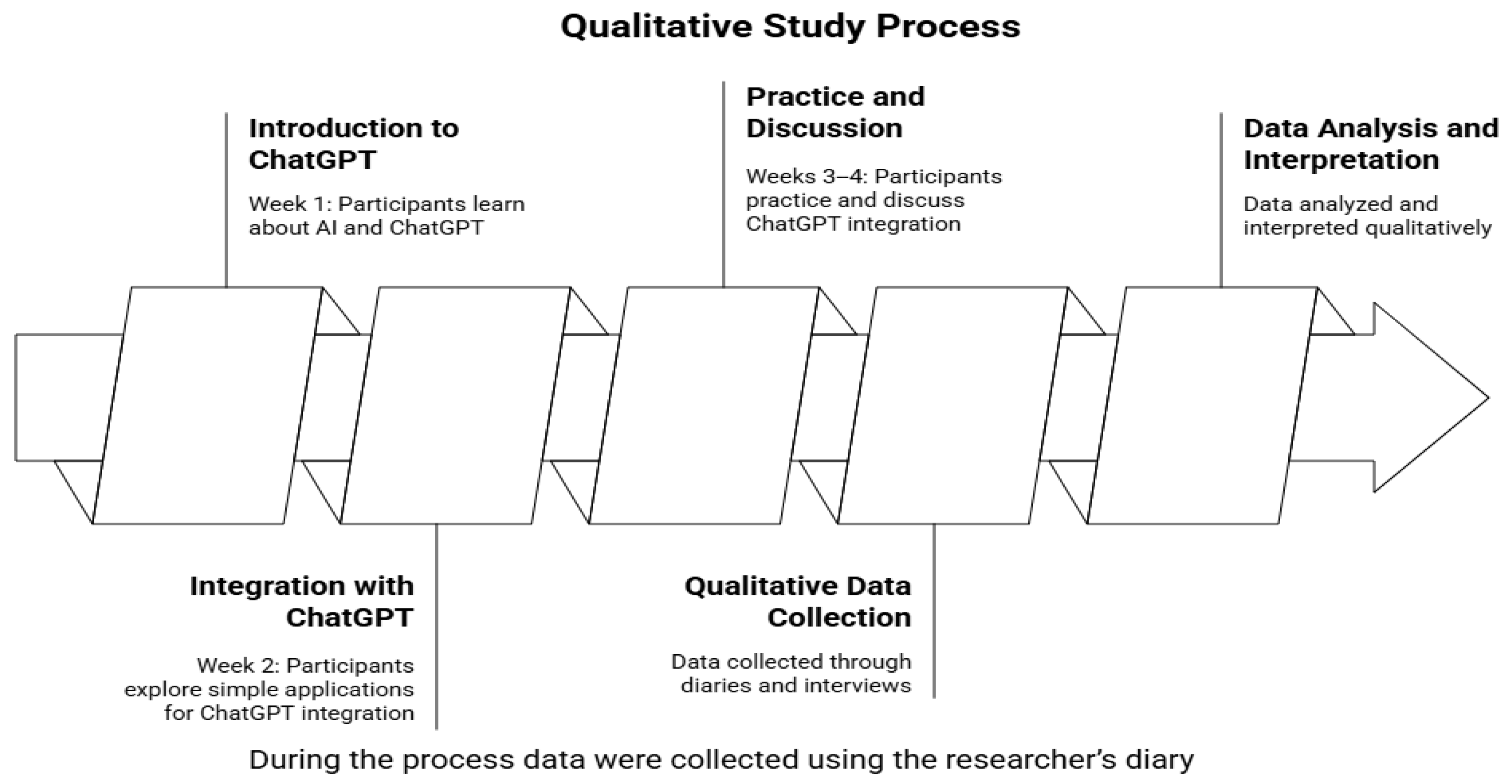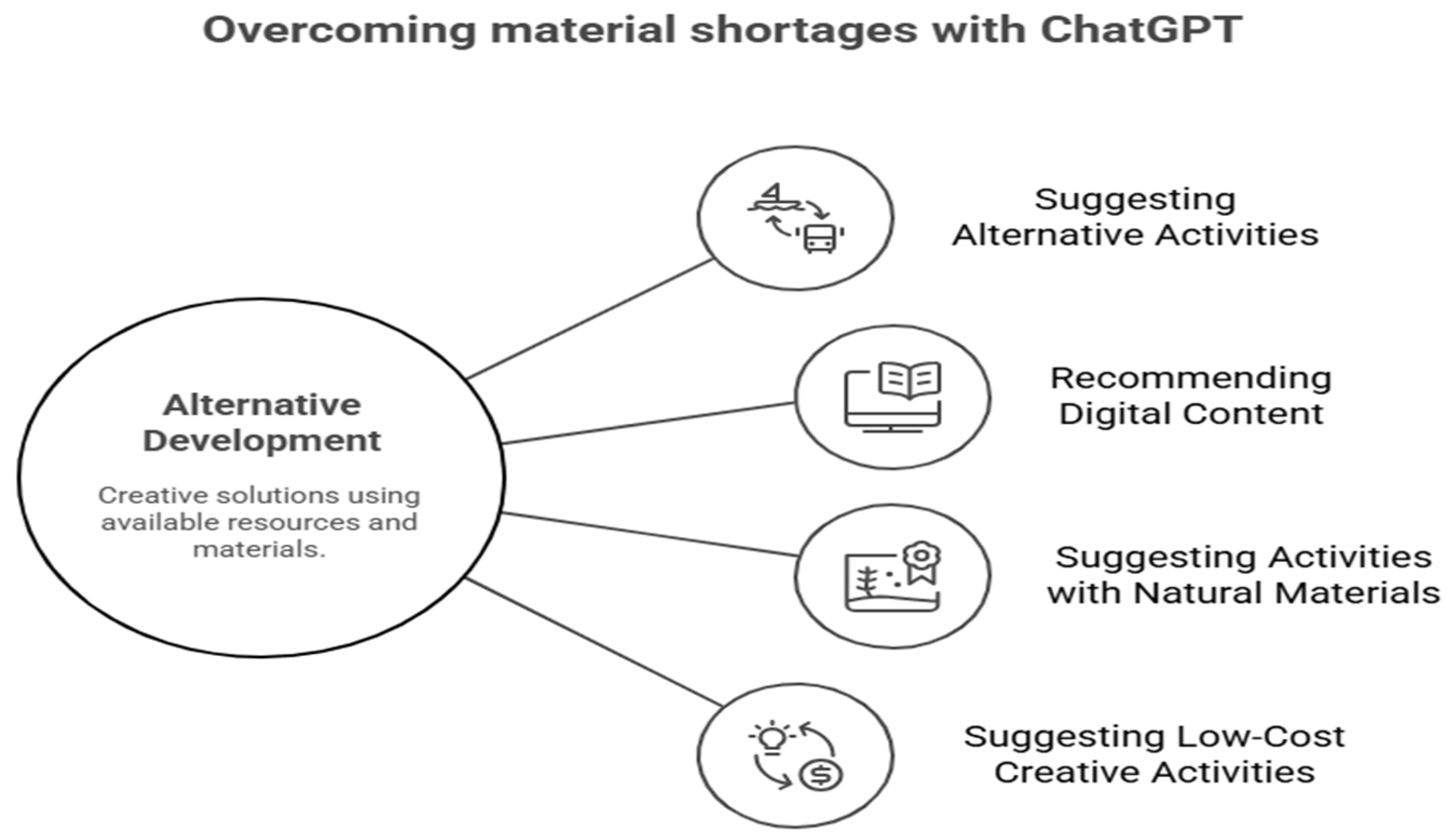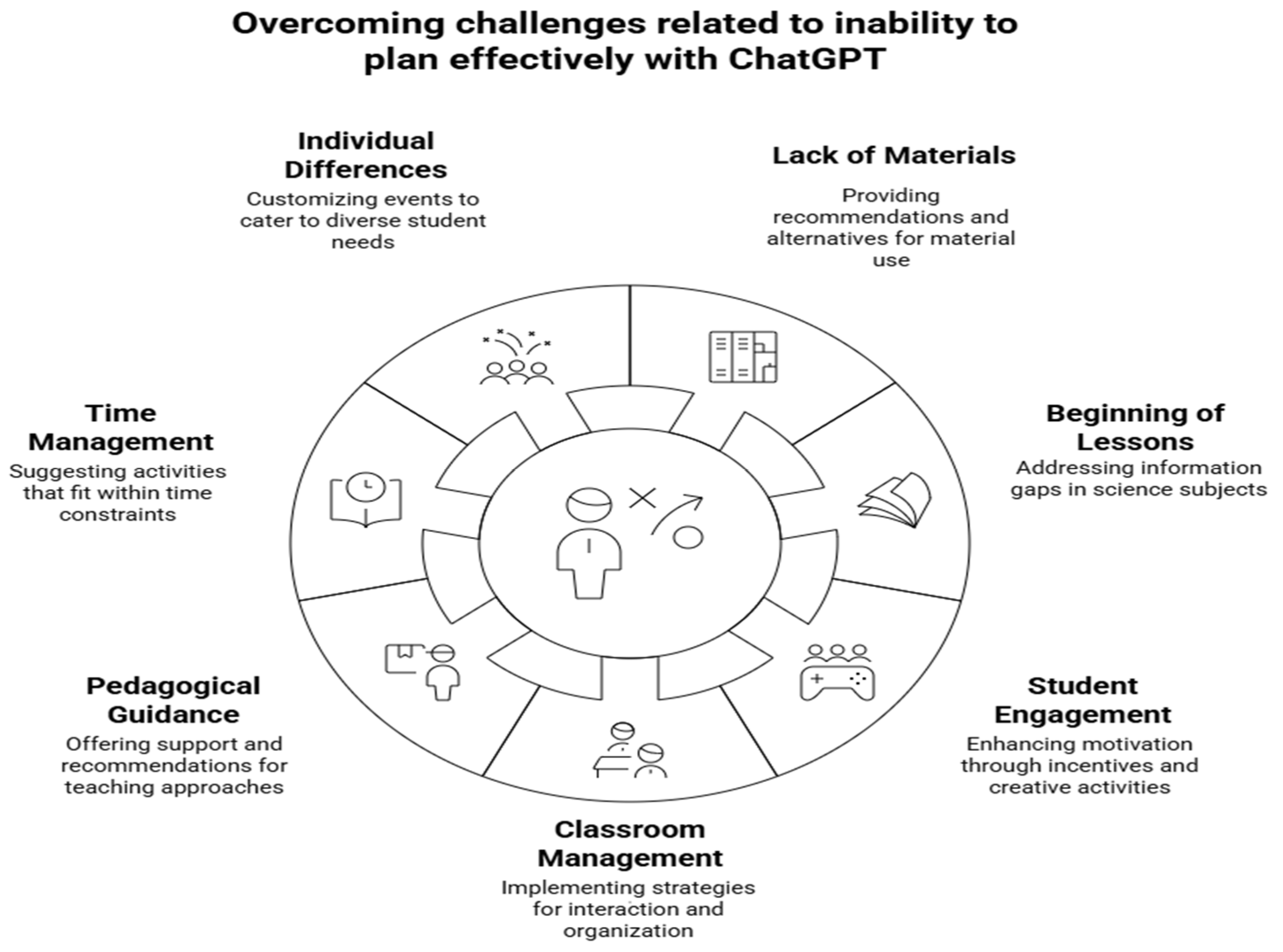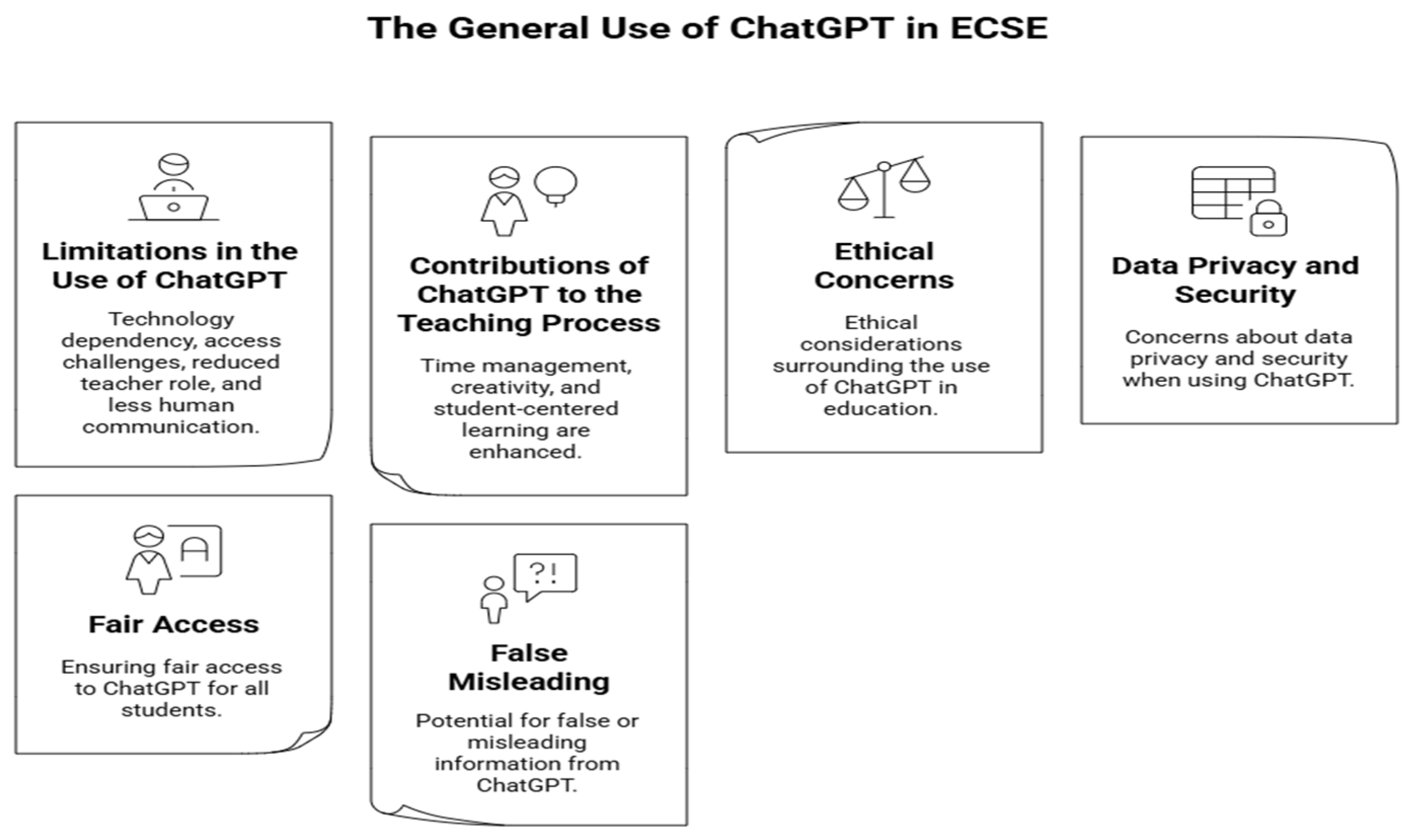ChatGPT in Early Childhood Science Education: Can It Offer Innovative Effective Solutions to Overcome Challenges?
Abstract
1. Introduction
Integrating ChatGPT in Early Childhood Science Education: Opportunities and Challenges
2. Materials and Methods
2.1. Objectives of the Study
2.2. Participants
2.3. Implementation Process
- Al and ChatGPT: Basic Concepts and Working Mechanisms
- Briefing for ECE Teachers on Introducing and Using ChatGPT
- The Effects of SA on Young Children’s Development
- Sample Applications for the Integration of ChatGPT into SA within the context of ECSE
- Participant Practices for the Integration of ChatGPT into SA within the context of ECSE
- Discussion and Review
- Evaluation
2.4. Data Collection
2.5. Data Collection Tool
2.6. Data Analysis
3. Results
3.1. ECE Teachers’ Views on How ChatGPT Can Contribute to Overcoming the Challenge of Lack of Materials in ECSE
3.2. ECE Teachers’ Views on How ChatGPT Can Contribute to Overcoming Challenges Related to Students’ Individual Differences in ECSE
3.3. ECE Teachers’ Views on How ChatGPT Can Contribute to Overcoming the Difficulty of Not Making Effective Plans in PSA
3.4. ECE Teachers’ General Opinions on the Use of ChatGPT in ECSE
4. Discussion
5. Conclusions
Author Contributions
Funding
Data Availability Statement
Conflicts of Interest
Appendix A
- How do you think ChatGPT will contribute to you in the process of overcoming the material deficiency you encounter in SA?
- How do you think ChatGPT will contribute to the process of overcoming the challenges related to the individual differences of the students you encounter in SA?
- How do you think ChatGPT will contribute to the process of overcoming the difficulties related to the inability to plan effectively?
- Teachers’ General Opinions on the Use of ChatGPT in Preschool Science Activities?
References
- Leggett, N. Creative and Critical Thinking in Early Childhood. In Integrated Education and Learning; Springer: Berlin/Heidelberg, Germany, 2023; pp. 109–127. [Google Scholar] [CrossRef]
- Moomaw, S. Teaching STEM in the Early Years: Activities for Integrating Science, Technology, Engineering, and Mathematics; Redleaf Press: St. Paul, MN, USA, 2024. [Google Scholar]
- Russell, T.; Martin, A.K. Learning to teach science. In Handbook of Research on Science Education; Routledge: Milton Park, UK, 2023; pp. 1162–1196. [Google Scholar]
- Cabe Trundle, K. The inclusion of science in early childhood classrooms. In Research in Early Childhood Science Education; Cabe Trundle, K., Saçkes, M., Eds.; Springer: Dordrecht, The Netherlands, 2015; pp. 1–6. [Google Scholar] [CrossRef]
- UNESCO. Early Childhood Care and Education: An Investment in Wellbeing, Gender Equality, Social Cohesion, and Lifelong Learning. 2022. Available online: https://www.unesco.org/en/early-childhood-education (accessed on 25 July 2025).
- Ravanis, K. Research trends and development perspectives in Early Childhood Science Education: An overview. Educ. Sci. 2022, 12, 456. [Google Scholar] [CrossRef]
- Drymiotou, I.; Constantinou, C.P.; Avraamidou, L. Enhancing students’ interest in science and understandings of STEM careers: The role of career-based scenarios. Int. J. Sci. Educ. 2021, 43, 717–736. [Google Scholar] [CrossRef]
- Jelks, S.M.; Crain, A.M. Sticking with STEM: Understanding STEM career persistence among STEM bachelor’s degree holders. J. High. Educ. 2020, 91, 805–831. [Google Scholar] [CrossRef]
- Kayan-Fadlelmula, F.; Sellami, A.; Abdelkader, N.; Umer, S. A systematic review of STEM education research in the GCC countries: Trends, gaps and barriers. Int. J. STEM Educ. 2022, 9, 2. [Google Scholar] [CrossRef]
- Lathwesen, C.; Belova, N. Escape rooms in STEM teaching and Learning—Prospective field or declining trend? A literature review. Educ. Sci. 2021, 11, 308. [Google Scholar] [CrossRef]
- Makransky, G.; Petersen, G.B.; Klingenberg, S. Can an immersive virtual reality simulation increase students’ interest and career aspirations in science? Br. J. Educ. Technol. 2020, 51, 2079–2097. [Google Scholar] [CrossRef]
- Murray, J. Routes to STEM: Nurturing science, technology, engineering and mathematics in early years education. Int. J. Early Years Educ. 2019, 27, 219–221. [Google Scholar] [CrossRef]
- Uhlenberg, J.M.; Geiken, R. Supporting young children’s spatial understanding: Examining toddlers’ experiences with contents and containers. Early Child. Educ. J. 2021, 49, 49–60. [Google Scholar] [CrossRef]
- Eshach, H.; Fried, M.N. Should science be taught in early childhood? J. Sci. Educ. Technol. 2005, 14, 315–336. [Google Scholar] [CrossRef]
- Aguilera, D.; Perales-Palacios, F.J. What effects do didactic interventions have on students’ attitudes towards science? A meta-analysis. Res. Sci. Educ. 2020, 50, 573–597. [Google Scholar] [CrossRef]
- Cordova, N., Jr.; Kilag, O.K.; Andrin, G.; Groenewald, E.; Abella, J. Promoting Literacy in Early Childhood: Leadership Practices and Long-Term Educational Impact. Excell. Int. Multidiscip. J. Educ. 2024, 2, 79–89. [Google Scholar] [CrossRef]
- Larimore, R.A. Preschool science education: A vision for the future. Early Child. Educ. 2020, 48, 703–714. [Google Scholar] [CrossRef]
- Liu, C.; Hwang, G.-J. Roles and research trends of touchscreen mobile devices in early childhood education: Review of journal publications from 2010 to 2019 based on the technology-enhanced learning model. Interact. Learn. Environ. 2023, 31, 1683–1702. [Google Scholar] [CrossRef]
- Wan, Z.H.; Jiang, Y.; Zhan, Y. STEM Education in Early Childhood: A Review of Empirical Studies. Early Educ. Dev. 2021, 32, 940–962. [Google Scholar] [CrossRef]
- Bjerknes, A.-L.; Wilhelmsen, T.; Foyn-Bruun, E. A systematic review of curiosity and wonder in natural science and early childhood education research. J. Res. Child. Educ. 2024, 38, 50–65. [Google Scholar] [CrossRef]
- Campbell, C.; Howitt, C. Science in Early Childhood; Cambridge University Press: Cambridge, UK, 2024. [Google Scholar]
- Yilmaz, M.M.; Siğirtmaç, A. A material for education process and the Teacher: The use of digital storytelling in preschool science education. Res. Sci. Technol. Educ. 2023, 41, 61–88. [Google Scholar] [CrossRef]
- Raviv, A.; Galili, I. Preschool teachers’ attitudes towards the implementation of science and technology studies in preschool. Early Child. Educ. J. 2024, 52, 575–585. [Google Scholar] [CrossRef]
- Raven, S.; Wenner, J.A. Science at the center: Meaningful science learning in a preschool classroom. J. Res. Sci. Teach. 2023, 60, 484–514. [Google Scholar] [CrossRef]
- Halaweh, M. ChatGPT in education: Strategies for responsible implementation. Contemp. Educ. Technol. 2023, 15, ep421. [Google Scholar] [CrossRef] [PubMed]
- Haleem, A.; Javaid, M.; Qadri, M.A.; Suman, R. Understanding the role of digital technologies in education: A review. Sustain. Oper. Comput. 2022, 3, 275–285. [Google Scholar] [CrossRef]
- Shen, Y.; Heacock, L.; Elias, J.; Hentel, K.D.; Reig, B.; Shih, G.; Moy, L. ChatGPT and Other Large Language Models Are Double-edged Swords. Radiology 2023, 307, e230163. [Google Scholar] [CrossRef] [PubMed]
- Uğraş, H.; Uğraş, M. ChatGPT in early childhood STEM education: Can it be an innovative tool to overcome challenges? Educ. Inf. Technol. 2024, 30, 4277–4305. [Google Scholar] [CrossRef]
- Uğraş, H.; Uğraş, M.; Papadakis, S.; Kalogiannakis, M. Innovative Early Childhood STEM Education with ChatGPT: Teacher Perspectives. Technol. Knowl. Learn. 2025, 30, 809–831. [Google Scholar] [CrossRef]
- Al Darayseh, A. Acceptance of artificial intelligence in teaching science: Science teachers’ perspective. Comput. Educ. Artif. Intell. 2023, 4, 100132. [Google Scholar] [CrossRef]
- Kasneci, E.; Sessler, K.; Küchemann, S.; Bannert, M.; Dementieva, D.; Fischer, F.; Gasser, U.; Groh, G.; Günnemann, S.; Hüllermeier, E.; et al. ChatGPT for good? On opportunities and challenges of large language models for education. Learn. Individ. Differ. 2023, 103, 102274. [Google Scholar] [CrossRef]
- Javaid, M.; Haleem, A.; Singh, R.P.; Khan, S.; Khan, I.H. Unlocking the opportunities through ChatGPT Tool towards ameliorating the education system. BenchCouncil Trans. Benchmarks Stand. Eval. 2023, 3, 100115. [Google Scholar] [CrossRef]
- Khosravi, T.; Al Sudani, Z.M.; Oladnabi, M. To what extent does ChatGPT understand genetics? Innov. Educ. Teach. Int. 2023, 61, 1320–1329. [Google Scholar] [CrossRef]
- Shai George, A.; Hovan George, A.S. A review of ChatGPT AI’s impact on several business sectors. Partn. Univ. Int. Innov. J. 2023, 1, 9–23. [Google Scholar] [CrossRef]
- Verma, M. The Digital Circular Economy: ChatGPT and the future of STEM Education and Research. Int. J. Trend Sci. Res. Dev. 2023, 7, 178–182. [Google Scholar]
- Rahman, M.M.; Watanobe, Y. ChatGPT for Education and Research: Opportunities, Threats, and Strategies. Appl. Sci. 2023, 13, 5783. [Google Scholar] [CrossRef]
- Vasconcelos, M.A.R.; Santos, R.P.D. Enhancing STEM Learning with ChatGPT and Bing Chat as Objects to Think with: A Case Study. Eurasia J. Math. Sci. Technol. Educ. 2023, 19, em2296. [Google Scholar] [CrossRef]
- Karademir, A.; Kartal, A.; Türk, C. Science education activities in Turkey: A qualitative comparison study in preschool classrooms. Early Child. Educ. J. 2020, 48, 285–304. [Google Scholar] [CrossRef]
- Yıldırım, B. Preschool STEM Activities: Preschool Teachers’ Preparation and Views. Early Child. Educ. J. 2021, 49, 149–162. [Google Scholar] [CrossRef]
- Demircan, H.Ö. “How am I supposed to do this on my own?”: A case study on perspectives of preschool teachers regarding integrative STEM practices. J. Early Child. Res. 2022, 20, 93–112. [Google Scholar] [CrossRef]
- Ramadhanta, S.A.; Simamora, R.E.; Susanti, D. Enhancing mathematical creative thinking ability: Experimentation with realistic mathematics education by embedding ice breaking in junior high school. EDU-MAT J. Pendidik. Mat. 2024, 12, 47–66. [Google Scholar] [CrossRef]
- Slim, T.; van Schaik, J.E.; Dobber, M.; Hotze, A.C.; Raijmakers, M.E. Struggling or Succeeding in Science and Technology Education: Elementary School Students’ Individual Differences During Inquiry-and Design-Based Learning. Front. Educ. 2022, 7, 842537. [Google Scholar] [CrossRef]
- Williams, A.J.; Danovitch, J.H.; Mills, C.M. Exploring Sources of Individual Differences in Children’s Interest in Science. Mind Brain Educ. 2021, 15, 67–76. [Google Scholar]
- Djonko-Moore, C.M. Diversity education and early childhood teachers’ motivation to remain in teaching: An exploration. J. Early Child. Teach. Educ. 2022, 43, 35–53. [Google Scholar]
- Çiftçi, A.; Topçu, M.S. Pre-service Early Childhood Teachers’ Challenges and Solutions to Planning and Implementing STEM Education–Based Activities. Can. J. Sci. Math. Technol. Educ. 2022, 22, 422–443. [Google Scholar] [CrossRef]
- Chew, S.L.; Cerbin, W.J. The cognitive challenges of effective teaching. J. Econ. Educ. 2021, 52, 17–40. [Google Scholar] [CrossRef]
- Darling-Hammond, L.; Flook, L.; Cook-Harvey, C.; Barron, B.; Osher, D. Implications for educational practice of the science of learning and development. Appl. Dev. Sci. 2020, 24, 97–140. [Google Scholar] [CrossRef]
- Wu, S.-Y.; Yang, K.-K. The effectiveness of teacher support for students’ learning of artificial intelligence popular science activities. Front. Psychol. 2022, 13, 868623. [Google Scholar] [CrossRef]
- Cooper, G. Examining science education in ChatGPT: An exploratory study of generative artificial intelligence. J. Sci. Educ. Technol. 2023, 32, 444–452. [Google Scholar] [CrossRef]
- Nee, C.K.; Rahman, M.H.A.; Yahaya, N.; Ibrahim, N.H.; Razak, R.A.; Sugino, C. Exploring the trend and potential distribution of chatbot in education: A systematic review. Int. J. Inf. Educ. Technol. 2023, 13, 516–525. [Google Scholar] [CrossRef]
- Taani, O.; Alabidi, S. ChatGPT in education: Benefits and challenges of ChatGPT for mathematics and science teaching practices. Int. J. Math. Educ. Sci. Technol. 2024, 1–30. [Google Scholar] [CrossRef]
- Creswell, J.W.; Creswell, J.D. Research Design: Qualitative, Quantitative, and Mixed Methods Approaches, 6th ed.; SAGE: Thousand Oaks, CA, USA, 2022. [Google Scholar]
- Merriam, S.B.; Tisdell, E.J. Qualitative Research: A Guide to Design and Implementation; John Wiley & Sons: Hoboken, NJ, USA, 2015. [Google Scholar]
- Yin, R.K. Case Study Research and Applications; Sage: Thousand Oaks, CA, USA, 2018; Volume 6. [Google Scholar]
- Glesne, C. Becoming Qualitative Researchers: An Introduction; Pearson: London, UK; Allyn & Bacon: Boston, MA, USA, 2016. [Google Scholar]
- Maxwell, J.A. Qualitative Research Design: An Interactive Approach; SAGE: Thousand Oaks, CA, USA, 2012. [Google Scholar]
- Vygotsky, L.S. Mind in Society: The Development of Higher Psychological Processes; Cole, M., John-Steiner, V., Scribner, S., Souberman, E., Eds.; Harvard University Press: Cambridge, MA, USA, 1978. [Google Scholar]
- Akkaş, H.; Meydan, C.H. Sampling Methods in Qualitative Sampling in Multicultural Settings. In Principles of Conducting Qualitative Research in Multicultural Settings; IGI Global: Hershey, PA, USA, 2024; pp. 32–54. [Google Scholar]
- Bengtsson, M. How to plan and perform a qualitative study using content analysis. NursingPlus Open 2016, 2, 8–14. [Google Scholar] [CrossRef]
- Elo, S.; Kyngäs, H. The qualitative content analysis process. J. Adv. Nurs. 2008, 62, 107–115. [Google Scholar] [CrossRef]
- Hsieh, H.-F.; Shannon, S.E. Three approaches to qualitative content analysis. Qual. Health Res. 2005, 15, 1277–1288. [Google Scholar] [CrossRef]
- Feser, M.S. Parents’ vıews On The Use Of Aı-Based Chatbots Such As Chatgpt In Hıgh School (Stem) Educatıon. J. Balt. Sci. Educ. 2024, 23, 4–8. [Google Scholar] [CrossRef]
- Opara, E.; Mfon-Ette Theresa, A.; Aduke, T.C. ChatGPT for teaching, learning and research: Prospects and challenges. Glob. Acad. J. Humanit. Soc. Sci. 2023, 5, 33–40. [Google Scholar] [CrossRef]
- Hussain, M.; Zhu, W.; Zhang, W.; Abidi, S.M.R. Student engagement predictions in an e-learning System and their impact on student course assessment scores. Comput. Intell. Neurosci. 2018, 1, 6347186. [Google Scholar] [CrossRef]
- Rahimi, A.R. Beyond digital competence and language teaching skills: The bi-level factors associated with EFL teachers’ 21st-century digital competence to cultivate 21st-century digital skills. Educ. Inf. Technol. 2024, 29, 9061–9089. [Google Scholar] [CrossRef]
- Wang, S.; Xu, T.; Li, H.; Zhang, C.; Liang, J.; Tang, J.; Yu, P.S.; Wen, Q. Large language models for education: A survey and outlook. arXiv 2024, arXiv:2403.18105. [Google Scholar] [CrossRef]
- Ellis, A.R.; Slade, E. A new era of learning: Considerations for ChatGPT as a tool to enhance statistics and data science education. J. Stat. Data Sci. Educ. 2023, 31, 128–133. [Google Scholar] [CrossRef]
- Zhai, X. ChatGPT for next generation science learning. XRDS Crossroads ACM Mag. Stud. 2023, 29, 42–46. [Google Scholar] [CrossRef]
- Karaer, G.; Hand, B.; French, B.F. Examining the impact of science writing heuristic (SWH) approach on development of critical thinking, science and language skills of students with and without disabilities. Think. Ski. Creat. 2024, 51, 101443. [Google Scholar] [CrossRef]
- Salman, O.; Khasawneh, Y.; Alqudah, H.; Alwaely, S.; Khasawneh, M. Tailoring gamification to individual learners: A study on personalization variables for skill enhancement. Int. J. Data Netw. Sci. 2024, 8, 789–796. [Google Scholar] [CrossRef]
- Wahab, S.A. Appreciative Leadership: A Mixed Methods Study of School Leadership in Pakistan. Ph.D. Thesis, University of Canterbury, Christchurch, New Zealand, 2023. [Google Scholar]
- Bae, C.L.; Lai, M.H. Opportunities to participate in science learning and student engagement: A mixed methods approach to examining person and context factors. J. Educ. Psychol. 2020, 112, 1128–1153. [Google Scholar] [CrossRef]
- Zhang, Y.; Yang, Y.; Huang, X. Effects of parental science expectations on the science interests of Yi Junior High School students in China: The chain mediating role of science experience and science self-efficacy. Res. Sci. Educ. 2024, 54, 827–844. [Google Scholar] [CrossRef]
- Dorouka, P.; Kalogiannakis, M. Teaching nanotechnology concepts in early-primary education: An experimental study using digital games. Int. J. Sci. Educ. 2024, 46, 1311–1338. [Google Scholar] [CrossRef]
- Kocoń, J.; Cichecki, I.; Kaszyca, O.; Kochanek, M.; Szydło, D.; Baran, J.; Bielaniewicz, J.; Gruza, M.; Janz, A.; Kanclerz, K.; et al. ChatGPT: Jack of all trades, master of none. Inf. Fusion 2023, 99, 101861. [Google Scholar] [CrossRef]
- Rathore, B. Future of AI & Generation Alpha: ChatGPT beyond Boundaries. Eduzone Int. Peer Rev. Multidiscip. J. 2023, 12, 63–68. [Google Scholar]
- Bunijevac, M. Parental involvement as a important factor for successful education. Cent. Educ. Policy Stud. J. 2017, 7, 137–153. [Google Scholar] [CrossRef]
- Roy, M.; Giraldo-García, R. The role of parental involvement and social/emotional skills in academic achievement: Global perspectives. Sch. Community J. 2018, 28, 29–46. [Google Scholar]
- Zhao, Y.; Yusof, S.M.; Hou, M.; Li, Z. How Can Generative Artificial Intelligence help Teachers in Early Childhood Education with their Teaching? Analyses from the Perspective of Teaching Methods. Int. J. Acad. Res. Prog. Educ. Dev. 2024, 13, 2314–2324. [Google Scholar] [CrossRef]
- Tram, N.H.M.; Tran-Thanh, V. The Role of Supportive Environments in Shaping EFL Teachers’ Adoption of ChatGPT. In Innovations in Technologies for Language Teaching and Learning; Springer: Berlin/Heidelberg, Germany, 2024; pp. 55–78. [Google Scholar]
- Al-khresheh, M.H. Bridging technology and pedagogy from a global lens: Teachers’ perspectives on integrating ChatGPT in English language teaching. Comput. Educ. Artif. Intell. 2024, 6, 100218. [Google Scholar] [CrossRef]
- Yan, D. Impact of ChatGPT on learners in a L2 writing practicum: An exploratory investigation. Educ. Inf. Technol. 2023, 28, 13943–13967. [Google Scholar] [CrossRef]
- Whalen, J.; Mouza, C. ChatGPT: Challenges, Opportunities, and Implications for Teacher Education. Contemp. Issues Technol. Teach. Educ. 2023, 23, 1–23. [Google Scholar]
- de Bem Machado, A.; Pesqueira, A.; Sousa, M.J. A Review ChatGPT and the Future of Education. In Digital Transformation in Higher Education Institutions; Springer: Berlin/Heidelberg, Germany, 2024; pp. 155–176. [Google Scholar]
- Berşe, S.; Akça, K.; Dirgar, E.; Kaplan Serin, E. The role and potential contributions of the artificial intelligence language model ChatGPT. Ann. Biomed. Eng. 2024, 52, 130–133. [Google Scholar] [CrossRef]
- Alshahrani, A. The impact of ChatGPT on blended learning: Current trends and future research directions. Int. J. Data Netw. Sci. 2023, 7, 2029–2040. [Google Scholar] [CrossRef]
- Lai, C.Y.; Cheung, K.Y.; Chan, C.S. Exploring the role of intrinsic motivation in ChatGPT adoption to support active learning: An extension of the technology acceptance model. Comput. Educ. Artif. Intell. 2023, 5, 100178. [Google Scholar] [CrossRef]
- Barenthien, J.; Oppermann, E.; Anders, Y.; Steffensky, M. Preschool teachers’ learning opportunities in their initial teacher education and in-service professional development–do they have an influence on preschool teachers’ science-specific professional knowledge and motivation? Int. J. Sci. Educ. 2020, 42, 744–763. [Google Scholar] [CrossRef]
- Lin, K.-Y.; Yeh, Y.-F.; Hsu, Y.-S.; Wu, J.-Y.; Yang, K.-L.; Wu, H.-K. STEM education goals in the twenty-first century: Teachers’ perceptions and experiences. Int. J. Technol. Des. Educ. 2023, 33, 479–496. [Google Scholar] [CrossRef]
- ElSayary, A. An investigation of teachers’ perceptions of using ChatGPT as a supporting tool for teaching and learning in the digital era. J. Comput. Assist. Learn. 2023, 40, 931–945. [Google Scholar] [CrossRef]
- Liu, J. ChatGPT: Perspectives from human–computer interaction and psychology. Front. Artif. Intell. 2024, 7, 1418869. [Google Scholar] [CrossRef] [PubMed]
- Sundar, S.S.; Liao, M. Calling BS on ChatGPT: Reflections on AI as a communication source. J. Commun. Monogr. 2023, 25, 165–180. [Google Scholar] [CrossRef]
- Yu, S.-C.; Chen, H.-R.; Yang, Y.-W. Development and validation the Problematic ChatGPT Use Scale: A preliminary report. Curr. Psychol. 2024, 43, 6159–6172. [Google Scholar] [CrossRef]
- Adeshola, I.; Adepoju, A.P. The opportunities and challenges of ChatGPT in education. Interact. Learn. Environ. 2023, 32, 6159–6172. [Google Scholar] [CrossRef]
- Wu, X.; Duan, R.; Ni, J. Unveiling security, privacy, and ethical concerns of chatgpt. J. Inf. Intell. 2023, 2, 102–115. [Google Scholar] [CrossRef]
- Rane, N.L.; Choudhary, S.P.; Tawde, A.; Rane, J. ChatGPT is not capable of serving as an author: Ethical concerns and challenges of large language models in education. Int. Res. J. Mod. Eng. Technol. Sci. 2023, 5, 851–874. [Google Scholar] [CrossRef]
- Zhou, J.; Müller, H.; Holzinger, A.; Chen, F. Ethical ChatGPT: Concerns, challenges, and commandments. Electronics 2024, 13, 3417. [Google Scholar] [CrossRef]
- Lewis, M.; Liu, Y.; Goyal, N.; Ghazvininejad, M.; Mohamed, A.; Levy, O.; Stoyanov, V.; Zettlemoyer, L. BART: De-noising Sequence-to-Sequence Pre-training for Natural Language Generation, Translation, and Comprehension. arXiv 2019, arXiv:1910.13461. [Google Scholar] [CrossRef]
- Rukman, W.Y.; Urath, S.; Harini, H.; Almaududi, A.M. Philosophy Education as a Means of Developing Student Soft Skills. Edumaspul Jurnal Pendidikan 2023, 7, 281–286. [Google Scholar]
- Zen, A.; Kusumastuti, R.; Metris, D.; Gadzali, S.S.; Ausat, A.M. Implications of entrepreneurship education as a field of study for advancing research and practice. J. Educ. 2023, 5, 11441–11453. [Google Scholar]
- Gilson, A.; Safranek, C.; Huang, T.; Socrates, V.; Chi, L.; Taylor, R.A.; Chartash, D. How Does ChatGPT Perform on the Medical Licensing Exams? The Implications of Large Language Models for Medical Education and Knowledge Assessment. medRxiv 2022, 12, 22283901. [Google Scholar] [CrossRef]
- Khan, R.A.; Jawaid, M.; Khan, A.R.; Sajjad, M. ChatGPT—Reshaping medical education and clinical management. Pak. J. Med. Sci. 2023, 39, 7653. [Google Scholar] [CrossRef]
- Jalil, S.; Rafi, S.; LaToza, T.D.; Moran, K.; Lam, W. ChatGPT and Software Testing Education: Promises & Perils. In Proceedings of the 2023 IEEE International Conference on Software Testing, Verification and Validation Workshops (ICSTW), Dublin, Ireland, 16–20 April 2023; pp. 4130–4137. [Google Scholar] [CrossRef]
- Mogali, S.R. Initial impressions of ChatGPT for anatomy education. Anat. Sci. Educ. 2023, 17, 444–447. [Google Scholar] [CrossRef]
- Celik, I. Towards Intelligent-TPACK: An empirical study on teachers’ professional knowledge to ethically integrate artificial intelligence (AI)-based tools into education. Comput. Hum. Behav. 2023, 138, 107468. [Google Scholar] [CrossRef]
- Wang, B.; Rau, P.-L.P.; Yuan, T. Measuring user competence in using artificial intelligence: Validity and reliability of artificial intelligence literacy scale. Behav. Inf. Technol. 2022, 42, 1324–1337. [Google Scholar] [CrossRef]
- Su, J.; Ng, D.T.K.; Chu, S.K.W. Artificial Intelligence (AI) Literacy in Early Childhood Education: The Challenges and Opportunities. Comput. Educ. Artif. Intell. 2023, 4, 100124. [Google Scholar] [CrossRef]
- Wang, C.; Liu, S.; Yang, H.; Guo, J.; Wu, Y.; Liu, J. Ethical Considerations of Using ChatGPT in Health Care. J. Med. Internet Res. 2023, 25, e48009. [Google Scholar] [CrossRef] [PubMed]
- Casebourne, I.; Shi, S.; Hogan, M.; Holmes, W.; Hoel, T.; Wegerif, R.; Yuan, L. Using AI to Support Education for Collective Intelligence. Int. J. Artif. Intell. Educ. 2024, 1–33. [Google Scholar] [CrossRef]
- Ashraf, M. A Systematic Review on the Potential of AI and ChatGPT for Parental Support and Child Well-Being. arXiv 2024, arXiv:2407.09492. [Google Scholar] [CrossRef]
- Kanaki, K.; Kalogiannakis, M. Sample design challenges: An educational research paradigm. Int. J. Technol. Enhanc. Learn. 2023, 15, 266–285. [Google Scholar] [CrossRef]





Disclaimer/Publisher’s Note: The statements, opinions and data contained in all publications are solely those of the individual author(s) and contributor(s) and not of MDPI and/or the editor(s). MDPI and/or the editor(s) disclaim responsibility for any injury to people or property resulting from any ideas, methods, instructions or products referred to in the content. |
© 2025 by the authors. Licensee MDPI, Basel, Switzerland. This article is an open access article distributed under the terms and conditions of the Creative Commons Attribution (CC BY) license (https://creativecommons.org/licenses/by/4.0/).
Share and Cite
Uğraş, M.; Çakır, Z.; Zacharis, G.; Kalogiannakis, M. ChatGPT in Early Childhood Science Education: Can It Offer Innovative Effective Solutions to Overcome Challenges? Computers 2025, 14, 368. https://doi.org/10.3390/computers14090368
Uğraş M, Çakır Z, Zacharis G, Kalogiannakis M. ChatGPT in Early Childhood Science Education: Can It Offer Innovative Effective Solutions to Overcome Challenges? Computers. 2025; 14(9):368. https://doi.org/10.3390/computers14090368
Chicago/Turabian StyleUğraş, Mustafa, Zehra Çakır, Georgios Zacharis, and Michail Kalogiannakis. 2025. "ChatGPT in Early Childhood Science Education: Can It Offer Innovative Effective Solutions to Overcome Challenges?" Computers 14, no. 9: 368. https://doi.org/10.3390/computers14090368
APA StyleUğraş, M., Çakır, Z., Zacharis, G., & Kalogiannakis, M. (2025). ChatGPT in Early Childhood Science Education: Can It Offer Innovative Effective Solutions to Overcome Challenges? Computers, 14(9), 368. https://doi.org/10.3390/computers14090368







